Asus Eee PC 900 Review
Asus Eee PC 900
After the roaring success of the original Eee PC, can Asus do even better with the sequel?
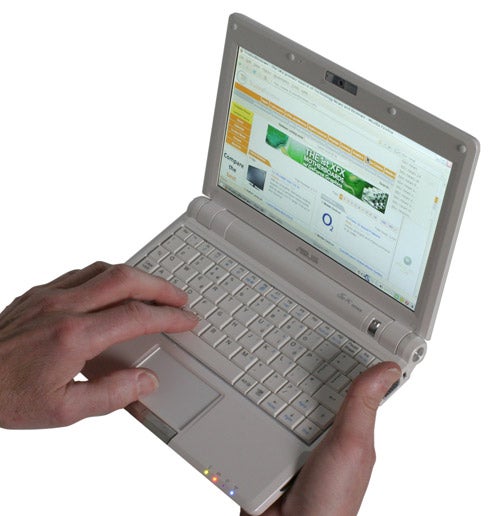
Verdict
Key Specifications
- Review Price: £329.00
Few could argue that Asus created something special when it launched the Eee PC last year. The idea of making a truly mobile, yet very affordable mobile computer was welcomed by the Press and consumers in equal measure. Although the Eee PC 4G 701 that Andy reviewed back in October 2007 was a great machine, there were a couple of issues that took away some of the shine. Now however, I have the Eee PC 900 to play with, and it looks as though Asus may have got everything just about perfect this time.
Anyone who’s got a few years under their belt, like myself, will be well aware that the concept of a basic, portable computer with solid state storage and no moving parts is nothing new. About ten years ago I did a significant amount of my writing on a Psion Series 5, which was laughably referred to as a PDA. In the Series 5, Psion created a device so usable, that I was able to write entire features on it while sitting on the train. The company then pushed the boundaries even further when it launched the Series 7 and eventually the NetBook.
What Psion got right with its machines was a balance of essential functionality, small form factor and great battery life. As time moved on, though, fully fledged notebooks became smaller and lighter and end users wanted to run feature rich (read bloated) operating systems on their mobile computers. All this spelled the end for Psion hardware (although it did spin off its EPOC OS as Symbian), and for a long time we simply didn’t see machines like the Series 7 and NetBook. Thankfully Asus realised that there was room in the market for a basic, affordable machine that didn’t need to run the latest version of Windows – thus the Eee PC was born. 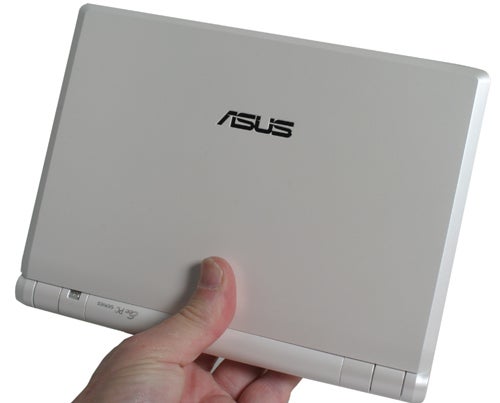
For anyone who hasn’t heard of the Eee PC before (where have you been hiding?), let me give you the low down. The Eee PC is a very small machine measuring 225 x 165 x 35mm (WxDxH) and weighing around 1kg. that puts it well and truly into the ultra-portable sector, being lighter than even a Sony TZ31MN, and smaller too. This is a machine built to be used on the move, without the need to make much space for it in your bag. The Eee PC comes in two colours, pearlescent white, like the one I’m reviewing here and black – yes, that does sound very similar to Apple’s MacBook range, but that’s most definitely where the similarities end.
Although the chassis that houses the Eee PC 900 is pretty much identical to the 701 that Andy reviewed last year, you only have to open the lid to see the first major difference between the two. The screen on the 900 is a huge improvement and one that makes this new Eee PC even more attractive than its predecessor. The 7in screen on the original Eee PC was hampered by the 800 pixel wide resolution, which meant that you had to scroll sideways on the vast majority of web pages. The 8.9in screen on the new model rectifies this issue by sporting a 1,024 pixel wide resolution, which allows it to display the vast majority of web pages perfectly, without the need for sideways scrolling.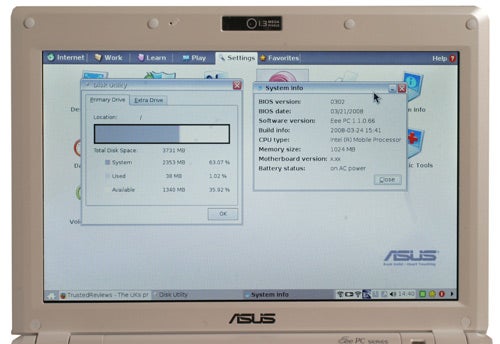
The full screen resolution is 1,024 x 600, which means you’ve got a widescreen aspect ratio, just like the majority of fully featured notebooks on the market. It should also be said that the quality of the screen in the Eee PC 900 is superb. OK, so it’s not gloriously bright and vivid like the screen in a Sony TZ, but it is evenly lit, has a wide viewing angle and this sample at least, suffered from no dead pixels. The 8.9in screen actually fills the lid properly too, whereas the 7in display in the 701 just looked tiny, flanked as it was by speakers and surrounded by a large black bezel. As well as offering much improved functionality, the new screen also improves the Eee PC aesthetically. 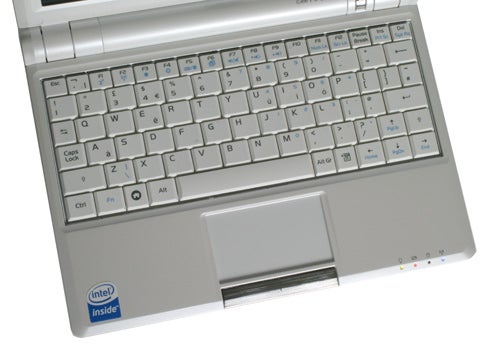
Considering the overall size of the Eee PC, it comes as no surprise that the keyboard is quite small. Anyone who struggles with a reduced size keyboard on a traditional ultra-portable notebook isn’t going to have much joy with an Eee PC, it really is that simple. However, if your hands aren’t too big, you shouldn’t have any problem typing – I’m currently writing this review on the Eee PC 900 and I can’t say that I’m typing much slower than if I was using a full size keyboard on a notebook or desktop. 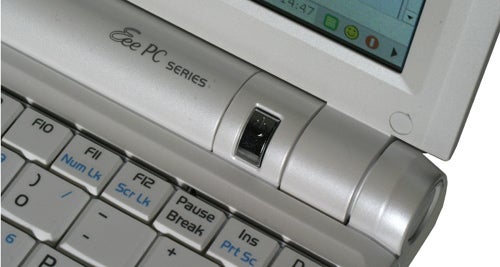
Also surprising is the amount of travel that each key has, and the fact that there’s a solid break at the end of each keystroke, ensuring that your finger bounces back up ready for the next attack. If there’s one small annoyance, it’s the reduced size Return key, which resembles the flat Enter style key seen on US keyboards. This isn’t anything that you won’t get used to after a short time, but I’d still rather have seen a larger Return.
Below the SpaceBar is the touchpad, which represents another major change from the older Eee PC 701. Not only is the touchpad far wider than that on the previous model, but it’s also multi-touch enabled. OK, so maybe I was premature when I said that the similarities with Apple would end with the colours, but I didn’t want to spoil the surprise! Just like on the MacBook Air, you can zoom in and out of images by pinching your fingers together, or pulling them apart. Of course, as with the MacBook Air, I’m not convinced that multi-touch is the killer feature that it is on the iPhone or iPod touch, but it’s great to see Asus squeezing such cutting edge technology into such an affordable machine.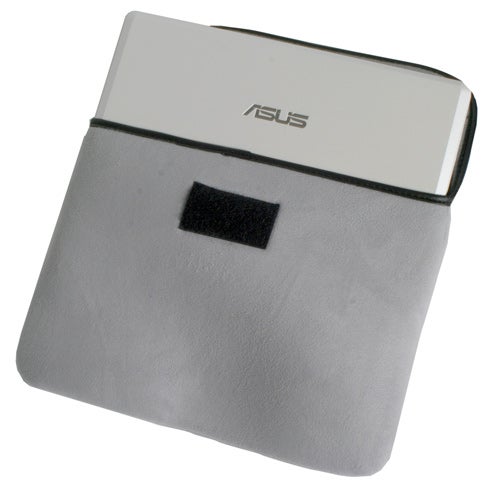
If you’re the kind of notebook user that has got used to using the right hand edge of the touchpad to scroll through documents, you’ll probably be disappointed to hear that the touchpad on the Eee PC 900 doesn’t support this feature. But don’t despair, because Asus has come up with a far better method. Instead of having to place your finger right at the edge of the touchpad to scroll, the Eee PC 900 will let you scroll from anywhere in the touchpad, as long as you use two fingers. The fact that you’re using two fingers tells the touchpad that you’re not just trying to move the pointer, and will consequently scroll through your document or webpage instead. The two finger scrolling method can be used for both vertical and horizontal scrolling.
There are some big changes inside too, although the CPU isn’t one of them. Despite the fact that many of us were hoping that the Eee PC 900 would be sporting Intel’s new Atom chip, unfortunately it’s not. In fact the basic platform is unchanged from the original model, with a 900MHz Intel Celeron processor residing in a 915GM based motherboard – hardly cutting edge, but more than capable of the job at hand. The first component improvement over the old 701 is the memory complement, with the new 900 sporting 1GB of RAM as standard, as opposed to the 512MB seen previously. The webcam has also been upgraded from a 0.3-megapixel unit to a 1.3-megapixel model – ideal for anyone who needs their friends to see them in even more detail while chatting on Skype.
The other major component upgrade is the amount of storage on offer. The original 701 had only 4GB of storage, while the 900 comes in two configurations – one with 12GB of storage and the other with 20GB. There’s no difference in price between these two versions because the 12GB model comes preloaded with Windows XP, while the 20GB version is running Linux. Basically Asus has used the money saved by installing an open source operating system to increase the storage. Of course if you really are set on Windows XP, the obvious suggestion would be to buy the Linux machine, then just install XP yourself – assuming that you have a spare copy of XP knocking about that is. 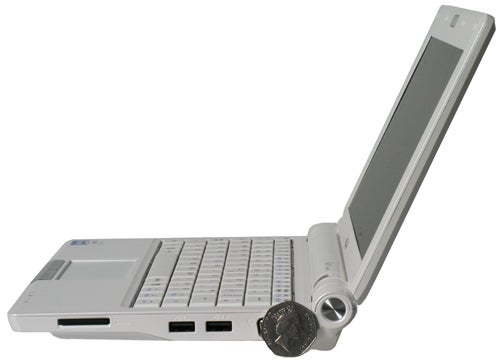
It’s the 20GB Linux version that I’ve got in front of me right now, and I have to say that I’m simply not convinced that I would ever need Windows XP on a machine like this. The beauty of the Eee PC is its simplicity, so filling it up with a heavy duty OS, when you simply don’t need the majority of the features it offers seems pointless. Unless you absolutely, positively have to run Windows applications like Microsoft Office, when you’re out and about, there’s pretty much nothing that you can’t do with the Linux version.
Performance wise, the Eee PC 900 zips along, without any of the tedious grinding that Windows Vista users will be used to. Unlike with Vista, 1GB of RAM is more than enough for a well configured Linux build, while the fast solid state storage also helps to ensure that the Eee PC 900 responds instantaneously to your commands. 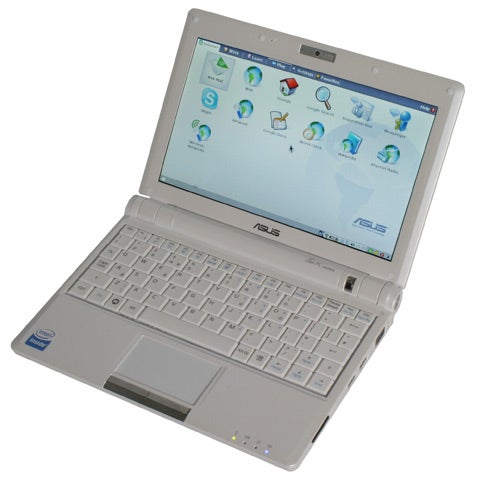
Navigation on the Linux install is unbelievably simple. You’re basically presented with a tabbed desktop, and clicking each tab will change the icons on offer to you on your desktop. The first tab is labelled Internet and unsurprisingly, all the icons are linked to Internet access in some way. Highlights include a Webmail button, which opens a page with various Webmail client icons such as Gmail and Hotmail. The Web icon will open the pre-installed Firefox browser, while the Skype and Google Docs icons will do exactly what it says on the tin. The Messenger button will launch Pidgin, which is a multi-protocol instant messenger client, that works very well. I especially like the fact that all your conversations happen in one window, with tabs for each person you’re talking to – this is very useful when desktop real estate is at a premium.
The Work tab gives you access to OpenOffice, for all your word processing, spreadsheet and presentation needs – and yes you can save in Microsoft Office format. Here you’ll also find a PDF reader, a simple notes program and a shortcut to Thunderbird for all your email needs. This is also where File manager lives, which basically equates to Windows Explorer and lets you search through all your folders.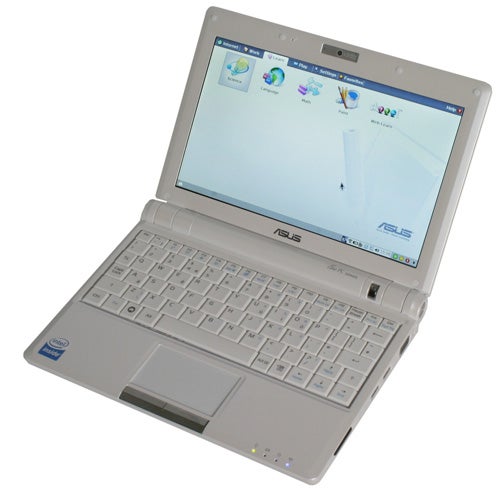
The Learn tab is clearly aimed at the education sector, which is a big part of the Eee PC market. Here you’ll find games and applications to help improve your vocabulary, spelling and even maths ability. There’s also a basic Paint program here, which is similar to the identically named application found in Windows, while the Science icon will give you access to a periodic table and a planetarium. 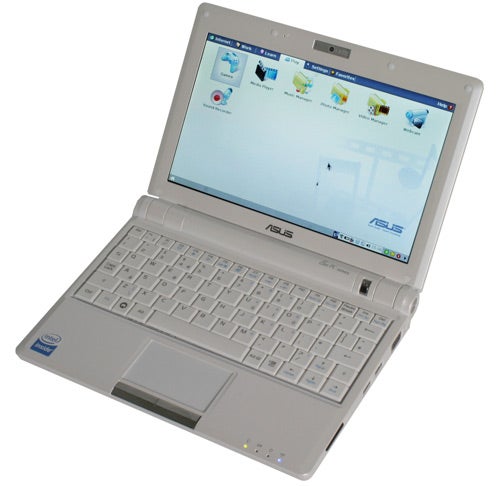
The Play tab brings up all the fun stuff like the Media Player, Music Manager and Webcam utility. There’s also a Sound Recorder and a Games icon, which gives you access to a handful of pre-loaded games, including the obligatory Solitaire.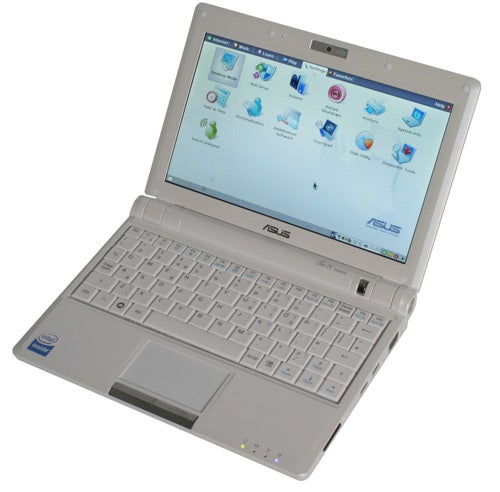
The Settings tab gives you access to all the system utilities and configuration applications. Here you can configure the touchpad, change the date and time, monitor disk usage and implement a virus scan of the system. The Add/Remove programs button also lives here, which not only lets you install or uninstall applications, but also checks for updates on all your installed programs. Finally the Favourites tab is just that, a place where you can store all your favourite links and shortcuts.
Despite the very small chassis, Asus has managed to squeeze in a surprising amount of connectivity. On the right you’ll find a D-SUB port for hooking the Eee PC 900 up to an external monitor. Next to this are two USB 2.0 ports, along with an SD card slot. Considering how cheap flash memory is these days, the SD card slot means that even if you do run low on internal storage, augmentation won’t be expensive.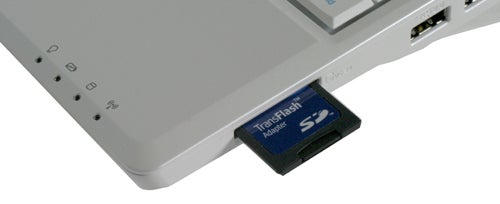
On the left there’s a third USB 2.0 port, which is one more than you’ll find on most fully featured ultra-portable notebooks. Here you’ll also find headphone and mic sockets – so you’ve got a choice of using a traditional or USB headset while taking advantage of that webcam and pre-installed Skype. Of course there is a microphone built into the lid of the machine, but you’re always better off using a proper headset. 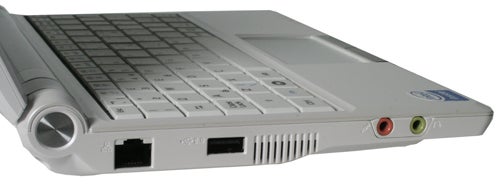
The final connection on the left is an Ethernet port for the 10/100 network adapter. It’s worth noting that the Apple MacBook air doesn’t have an Ethernet port, despite being considerably larger and heavier than the Eee PC 900, making Apple’s machine look like a lightweight in metaphorical rather than literal terms. Of course you also get 802.11b/g wireless built-in – Draft-N would have been nice, but let’s hope that when the Atom version arrives it wll be Draft-N compliant.
If there’s one area where the new Eee PC 900 doesn’t really improve on its predecessor, it’s battery life, and that’s a real shame. With the improvements that Asus has made in this new Eee PC model, battery life is about the only chink in its armour worth mentioning, but it’s still a significant chink. Asus quotes 2.5-hours battery life for this machine, but I barely got two hours out of it, although to be fair I had the screen on full brightness and wireless running. Perhaps with a bit of a tweak to the brightness and more frugal use of wireless I could have matched Asus’ estimate, but even then, two and a half hours isn’t much by today’s standards. 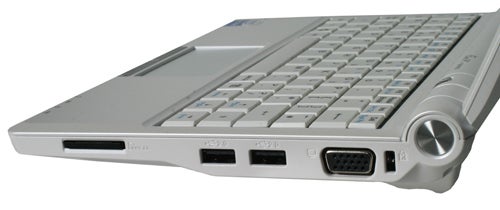
Ideally I’d like to see at least four hours battery life out of an Eee PC, especially since full fat ultra-portable machines like the Sony TZ can last well over six hours. Of course you can buy a larger battery for the Eee PC, but that will push both the price and the weight up. On the plus side, the power brick is tiny, so it wouldn’t be too much of a chore to carry around with you, but that’s not going to help you if you want to work out in the garden, or perhaps in a park where there are no plug sockets.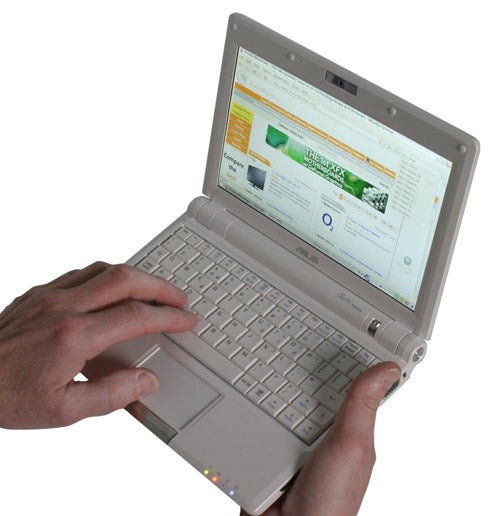
Battery life aside, Asus has thrown enough enhancements into the Eee PC 900 to make it a very attractive proposition for anyone who’s thinking of buying a small, thin and light notebook. Of course those enhancements have also pushed the price up, with the Eee PC 900 costing £329 instead of £219. Even so, I can’t see too many people being put off by the higher price point. In fact some of the guys in the office have already said that they’ll be buying one of these little notebooks as soon as they get paid.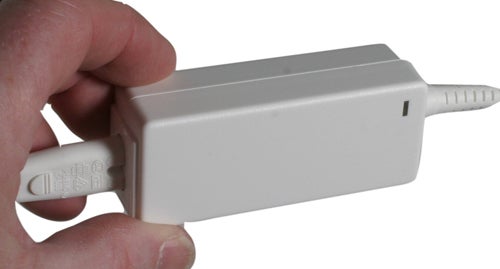
”’Verdict”’
Asus has done a brilliant job of updating an already great product. The engineers have clearly listened to all the comments regarding the original Eee PC and attempted to put them right. The 1,024 wide screen makes the Eee PC 900 a joy to use, especially if you spend a lot of your time in a browser window. The extra memory and storage are also very welcome additions, and help make this version of the Eee PC a real alternative to a fully featured notebook.
Yes the price is higher than the previous model, but I personally believe that the Eee PC 900 still represents staggering value for money. Ultimately, if you want a notebook that’s small, light and still very affordable, the Eee PC 900 should be top of your list.
”’Related Articles”’
ASUS Eee PC 4G 701 review
ASUS Eee PC 901 20G Linux Edition review
How we test laptops
Unlike other sites, we test every laptop we review thoroughly over an extended period of time. We use industry standard tests to compare features properly. We’ll always tell you what we find. We never, ever, accept money to review a product.
Trusted Score
Score in detail
-
Performance 8
-
Design 9
-
Value 10
-
Features 8

